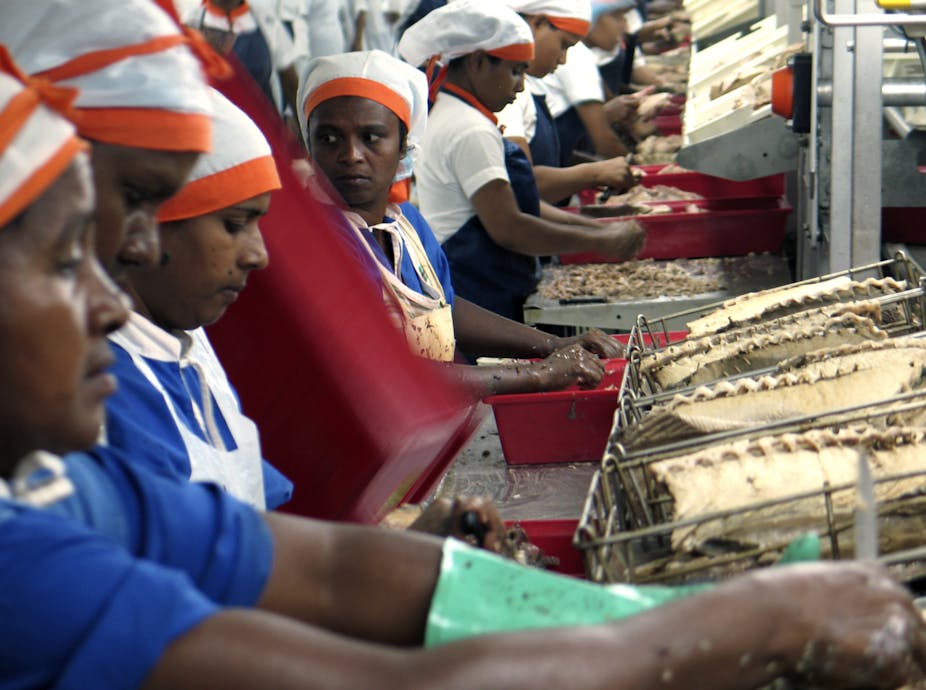Mauritius, an island with no indigenous populations and a history of multiple European colonisations, is a multi-ethnic society made up of just over two thirds Indo Mauritians, nearly one third Creoles and small groups of Sino-Mauritians and Franco-Mauritians.
The social fabric of the island of nearly 1.3 million people is a reflection of its history of involuntary and voluntary migrations. Its population has been constituted by flows of people since the 16th century. These flows have consisted of colonial administrators and merchants, sugar plantation owners, African slaves, Indian indentured labourers, traders and, most recently, large numbers of Chinese and Bangladeshi migrant workers.
On November 2 Mauritius commemorates the arrival of the first indentured migrants with a national holiday. It is a timely moment to reflect on current labour conditions on the island, and to ask to what extent they reproduce colonial indenture practices.
Since its independence Mauritius has been showcased as an economic “miracle” and a peaceful society where several ethnic groups live in harmony. In reality this harmony is precarious and the idea of the “Mauritian miracle” masks a significant social malaise that cannot be separated from contemporary labour conditions.
From slavery to indenture
The first inhabitants of Mauritius were African slaves and the French settlers that forcibly brought them there. With the spread of sugar cultivation on the island, by 1806 the slave population had grown to 63,000.
After the British conquest in 1810 and following the abolition of slavery in 1835, Indian indentured labourers were brought to the island to continue work on the sugar plantations.
Indenture is generally considered “free labour” when compared with slavery. Indentured labourers are generally recruited rather than kidnapped and they are paid wages.
But in reality the system of recruitment and contractual arrangements placed the indentured workers under the total control of plantation owners. Many were deceived into migrating and several were confined in poor accommodation, completely isolated from relatives on other plantations. Planters relied on punishment and confinement to extract maximum labour from migrants. They also curtailed their mobility and prevented them from leaving the plantation.
This led some, like scholar Hugh Tinker, to conclude that the indentured labour system was merely “slavery by another name”.
From indenture to independence
Indentured labour formally came to an end in 1910. Between 1834 and 1910 more than 450,000 migrants of Indian origin (mainly Hindus) disembarked in Port Louis. This mass migration drastically changed the island’s ethnic distribution. From a Creole island, Mauritius became a Hindu dominated society.
In the 1880s and 1890s a process gained momentum that would once again reshape the power structures of Mauritian society. Morcellement schemes – involving the sale of small tracts of land to former labourers – saw land passing into the hands of many Indo-Mauritians. These former indentured labourers came to form a new Indian small planter class which played an active role in colonial economic life.
The descendants of indentured migrants would eventually come to political power in 1968 when the island gained independence from Britain.
The “Mauritian miracle” and foreign labour
Independence saw the establishment of a garment manufacturing sector, a rise in luxury tourism and the recovery of the sugar industry. These resulted in impressive growth rates in post-colonial Mauritius. By the 1990s, in what has been dubbed the “Mauritian miracle”, the island established itself as a middle income country.
But newly industrialised Mauritius once again faced a labour scarcity problem. It addressed this by importing contract workers from low-wage economies in the developing world. This came more than 80 years after the end of the colonial indentured labour system.
As the demand for factory workers in the flourishing export processing zones increased in the 1980s, Mauritian employers began looking to other South Asian countries to recruit labour migrants.
Employers soon realised that “foreign labour” was more flexible and that migrant workers were ready to accept poor conditions of work and overtime. By 2014 more than 38,000 workers, mainly from Bangladesh and China, were employed on the island.
Recent studies have drawn parallels between colonial indenture practices and the modern day contracting of migrant workers.
Despite government regulations and controls there are reports of ongoing abuse of migrants. The local newspaper L’express has described Bangladeshi migrant labour in Mauritius as “a real trafficking of modern coolies”.
The challenges they face include:
The threat of deportation. Recently 10 Bangladeshis working in a factory had their mobile phones confiscated and were deported without any explanation.
Overcrowded and poorly furnished accommodation.
The recruitment process often leads to bitter disappointment and high levels of debt bondage. This is because migrant workers pay middlemen and unscrupulous recruiters to get employment.
It seems ironic that a nation made up mainly of descendants of slaves and immigrants should treat its foreign workers poorly. Today’s migrant workers may not be coerced by colonial economic imperatives such as the mass transportation of “coolies” in the 19th century. But, arguably, postcolonial capitalist economies exploit the vulnerabilities and inequalities that globalisation has produced without weighing the long term consequences.
Ethnic vulnerabilities and Mauritian nationalism
Mauritian fiction writers are increasingly exposing the darker side of the Mauritian “miracle” –- its communalism, intolerance and social prejudices.
They suggest that it has not provided equal access to resources for all Mauritians. Nor has it improved the lot of disadvantaged Creole communities, referred to as the “malaise créole”.
The segregation and discrimination imposed on migrant labourers only compounds the tension between groups. Problems of rising unemployment and the continued creole malaise are social problems that have not been resolved. The presence of “foreign” workers could very easily further fuel violent ethnic tensions.
The danger is that the arrival of modern day “coolies” could easily transform the persisting “malaise créole” into a “malaise Mauricien”.

